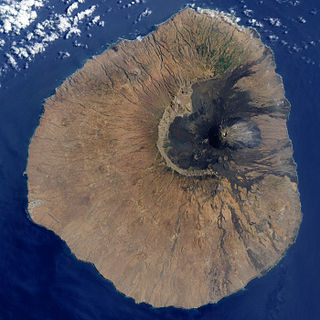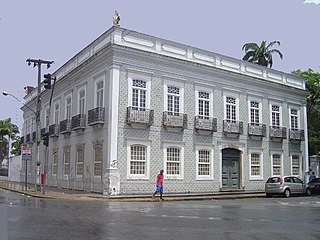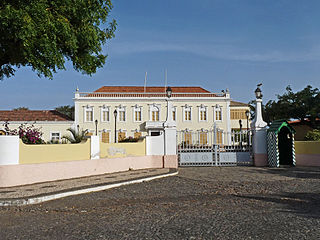
Fogo is an island in the Sotavento group of Cape Verde. Its population is 35,837 (2015), with an area of 476 km2. It reaches the highest altitude of all the islands in Cape Verde, rising to 2,829 metres above sea level at the summit of its active volcano, Pico do Fogo.

Pico do Fogo[ˈpiku du ˈfoɡu] is the highest peak of Cape Verde and West Africa, rising to 2,829 metres (9,281 ft) above sea level. It is an active stratovolcano lying on the island of Fogo. The main cone last erupted in 1680, causing mass emigration from the island. A subsidiary vent erupted in 1995. The only deadly eruption was in 1847 when earthquakes killed several people.
Luís Romano de Madeira Melo was a bilingual poet, novelist, and folklorist who has written in Portuguese and the Capeverdean Crioulo of Santo Antão.
Cape Verdean Creole is a Portuguese-based creole language spoken on the islands of Cape Verde. It is also called Kriolu or Kriol by its native speakers. It is the native creole language of virtually all Cape Verdeans and is used as a second language by the Cape Verdean diaspora.
Cape Verdean Americans are an ethnic group of Americans whose ancestors were Cape Verdean. In 2010, the American Community Survey stated that there were 95,003 Americans living in the US with Cape Verdean ancestors.
Santiago Creole is the name given to the Cape Verdean Creole spoken mainly on Santiago Island of Cape Verde. It belongs to the Sotavento Creoles branch of Creole.

Claridade was a literary review inaugurated in 1936 in the city of Mindelo on the island of São Vicente, Cape Verde. It was part of a movement of cultural, social, and political emancipations of the Cape Verdean society. The founding contributors were Manuel Lopes, Baltasar Lopes da Silva, who used the poetic pseudonym of Osvaldo Alcântara, and Jorge Barbosa, born in the Islands of São Nicolau, Santiago and São Vicente, respectively. The magazine followed the steps of the Portuguese neorealist writers, and contributed to the building of "Cape Verdeanity", an autonomous cultural identity for the archipelago.

The Culture of Cape Verde is rich, with a range of customs and practices common in the islands.

Chiquinho is a Capeverdean novel written by Baltasar Lopes da Silva in 1936 and published in 1947. The story is named after the nickname of the island of São Nicolau in which the characters originated. The probability of the literary work is the most common in Cape Verde, it marked the beginning of the typical literature in Cape Verde along with local themes in Creole culture. Along with Claridade, Baltazar Lopes participated with Manuel Lopes and Jorge Barbosa with founded members of the review and the name was the movement in the main activists of the same.

Henrique Teixeira de Sousa was a doctor and author from Cape Verde.

Cape Verde or Cabo Verde, officially the Republic of Cabo Verde, is an archipelago and island country in the central Atlantic Ocean, consisting of ten volcanic islands with a combined land area of about 4,033 square kilometres (1,557 sq mi). These islands lie between 600 and 850 kilometres west of Cap-Vert, the westernmost point of continental Africa. The Cape Verde islands form part of the Macaronesia ecoregion, along with the Azores, the Canary Islands, Madeira, and the Savage Isles.

Grogue, also known as grogu or grogo, is a Cape Verdean alcoholic beverage, an aguardente made from sugarcane. Its production is fundamentally artisanal, and nearly all the sugarcane is used in the production of grogue. The cane is processed in a press known as a trapiche.
The Island of Contenda is a 1995 drama film directed by Leão Lopes.
Certeza was a Cape Verdean literary review established in Praia in 1944. Although the paper was less notoriety than its predecessor Claridade founded in 1936, nevertheless, it was a milestone in Cape Verdean literature.

The Literature of Cape Verde is among the most important in West Africa, it is the second richest in West Africa after Mali and modern day Mauritania. It is also the richest in the Lusophone portion of Africa. Most works are written in Portuguese, but there are also works in Capeveredean Creole, French and notably English.

The cuisine of Cape Verde is a West African cuisine largely influenced by Portuguese, Southern and Western European and West African cuisine. Cape Verde was a colony of Portugal from its colonization until 1975.

A sobrado is a type of house style building from the Portuguese colonial era, typical in Brazil and other former Portuguese colonies. It is a form equivalent to the Anglo-American townhouse, particularly the creole townhouse in Louisiana. Featuring typically two floors with a balcony, the sobrados were the residences of the urban notable people, notably in the former capital of Brazil, Salvador. They are also found in Cape Verde, particularly in São Filipe on the Fogo island, and in Angola, in Luanda.

The Architecture of Cape Verde has different architectural styles in the nation. Unlike the African mainland, Cape Verde was uninhabited until 1461 when the Portuguese arrived, most of the other islands were first inhabited after the end of the 15th century. Its architecture was introduced in the 1460s and has its first origins from Portuguese settlers from the Madeira Islands, after the first arrival of mainland Africans, a bit of African architecture would be elements mainly in rural areas. The Manueline was its first architectural style on the island, it was later followed by Renaissance, Baroque, Pombaline, Early Modern and Modern. It was one of the last in the whole of Africa to introduce architecture late. Cape Verde has one of the richest architecture in the western portion of West Africa, the sub-Saharan portion, the richest probably being Mali.

Funco is a traditional Capeverdean house that originated in Africa.
Pedro Monteiro Cardoso was a Cape Verdean writer, poet and folklorist.












